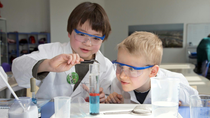Butterfly — fly!
The colors of nature are always inspirational to us. When natural plant pigments encounter chemistry, a remarkable color tour is therefore unfolded. In this year’s BASF Kids’ Lab, children learnt to use everyday materials rather than a brush to color their paper butterflies, creating a lot of unique and beautiful patterns while exploring t of the acid-base property of of materials.
Paint your walls to bring your home a new look, and apply spray coating on your car to make it look more dynamic. Everyone enjoys the refreshment of colors. If you have a playful spirit, follow Dr. Bubble to create your own colors!
Mallow flower is a purple flower native to Europe, which is known as the miracle of flower. It initially assumes a bright blue and then gradually turns purple as it reacts with oxygen in the air. After adding some lemon juice to it, the color will evolve to red purple and eventually to beautiful pink, like the glow of the dawn sky. It contains an amazing pigment called anthocyanin, whose color can change as the environmental pH changes.
Materials
For coloring — mallow tea, lemon juice, sodium soap, cotton swabs, white watercolor correction pen, paperboard with a butterfly pattern (attached with the publication)
Auxiliary materials — tape, colored iron wire, iron sheets, sponges, scissors
Procedures
Step 1. Use a sponge dipped with mallow tea to color the butterfly on paperboard.
Step 2. Use a cotton swab dipped with lemon juice and sodium soap to paint the butterfly with beautiful patterns. Find the surprising effect with the correction pen.
Step 3. Use scissors to cut off the butterfly along the black line.
Step 4. Use adhesive tape to fix iron sheets inside the black circles at the back of butterfly wings.
Step 5. Add a butterfly body: fix the colored iron wires in the middle of the wings with adhesive tape.
Step 6. Slightly fold down the wings.
Step 7. Let the butterfly fly at your fingertips!
More about Anthocyanin
Anthocyanin changes color as the pH changes, and thus is a natural acid- base indicator: it assumes red when encountering acid, purple in neutral environment and blue or green when added with base. We can use mallow tea to test what else in our kitchen is acidic or alkaline.
Besides mallow flower, grapes, blueberries, strawberries, eggplant, purple cabbage, purple sweet potato, hydrangea and morning glory can also change color under the same principle.
Anthocyanin is a powerful antioxidant that protects human body from damage caused by free radicals or other hazardous substances. What’s more, anthocyanin is also able to enhance blood vessel flexibility, improve circulation and skin smoothness, inhibit inflammation and allergies, as well as improve joint flexibility.
